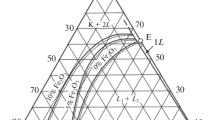Abstract
This study was made with the aim of developing a process for liquation fusion of rare earth–rare metal ocherous ores of carbonatite weathering crust deposits. The formation of two immiscible melts, silicate and phosphate–salt, in the monazite–SiO2–NaF–Nb2O5 system was studied. The melt liquation field in the isotherm occupies 50% of the diagram area at 1200°C, 39.0% at 1100°C, 20.0% at 1000°C, and <5% at 900°C. The silicate melt can be readily quenched into a glass containing fine spherical droplets of the phosphate–salt melt. The phosphate–salt melt is always in the crystalline state. The phosphate–salt melt and phosphate–salt spheres contain double phosphates and fluoride phosphates of rare earth elements (REEs) and sodium. Nb2O5 concentrates in the silicate melt. REE oxides, Nb2O5, and other components are distributed between the two coexisting melts in the contrast fashion. Rare earth oxalate and hydroxide concentrates were obtained from the phosphate–salt melt, and commercial niobium product containing ≤0.50% Р2О5, from the silicate melt.




Similar content being viewed by others
REFERENCES
Delitsyn, L.M., Mekhanizm likvatsii v prirodnykh i tekhnologicheskikh silikatno-solevykh rasplavakh — kontsentratorakh redkikh zemel' i niobiya (The Mechanism of Segregation in Natural and Technological Silicate-Salt Melts: Concentrators of Rare Earths and Niobium), Moscow: GEOS, 2018.
Tolstov, A.V. and Pokhilenko, N.P., Ekonomika i Organizatsiya Promyshlennogo Proizvodstva, 2012, no. 11, pp. 17–27.
Serebrennikov, V.V., Khimiya redkozemel'nykh elementov (Chemistry of Rare Earth Elements), Tomsk: Izd. Tomsk. Univ., 1961.
Cheremesina, O.V., Tsv. Metally, 2009, no. 12, pp. 45–52.
Polyakov, E.G., Nechaev, A.V., and Smirnov, A.V., Metallurgiya redkozemel'nykh metallov (Metallurgy of rare earth metals), Moscow: Metallurgiya, 2018.
Likhnikevich, E.G., Ozhogina, E.G., Astakhova, Yu.M., and Fatov, A.S., Zoloto Tekhnologii, 2016, vol. 34, no. 4, pp. 68–71.
Sarychev, G.A., Tarasov, A.V., Kosynkin, V.D., Trubakov, Yu.I., and Smirnov, K.M., Abstracts of Papers, Mezhdunar. nauch.-prakt. konf. “Aktual'nye voprosy polucheniya i primeneniya RZM i RM — 2017” (Int. Sci. Pract. Conf. on Actual Problems of Production and Application of REE and RE, 2017), Moscow: OAO Institut GINTsVETMET, 2017.
Delitsyn, L.M., Melent'ev, G.B., Tolstov, A.V., Magazina, L.O., and Samonov, A.E., Redkie Zemli, 2015, vol. 5, no. 2, pp. 164–179.
ACKNOWLEDGMENTS
The author is grateful to staff members of the Joint Institute for High Temperatures, Russian Academy of Sciences: Cand. Sci. (Phys.-Math.) T.I. Borodina, senior researcher of the laboratory of shock waves in condensed media, for performing X-ray diffraction analysis; G.E. Val’yano, senior researcher of the laboratory of shock waves in condensed media, for performing analyses with an electron microscope; Cand. Sci. (Chem.) R.V. Kulumbegov, senior researcher of the laboratory of gas turbine technologies, for assisting in manuscript editing.
Funding
The study was financially supported by the Russian Foundation for Basic Research (project no. 17-08-00583).
Author information
Authors and Affiliations
Corresponding author
Ethics declarations
The author declares that he has no conflict of interest.
Additional information
Translated from Zhurnal Prikladnoi Khimii, No. 4, pp. 472–481, January, 2021 https://doi.org/10.31857/S004446182104006X
Rights and permissions
About this article
Cite this article
Delitsyn, L.M. An Experimental Study of the Melt Immiscibility and Distribution of Rare Earth Elements, Р2О5, and Nb2O5 between Immiscible Melts in the Monazite–SiO2–NaF–Nb2O5 System. Russ J Appl Chem 94, 468–477 (2021). https://doi.org/10.1134/S1070427221040066
Received:
Revised:
Accepted:
Published:
Issue Date:
DOI: https://doi.org/10.1134/S1070427221040066




